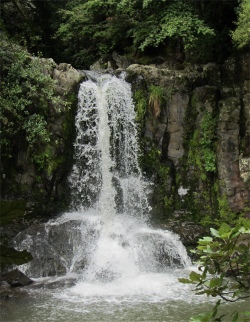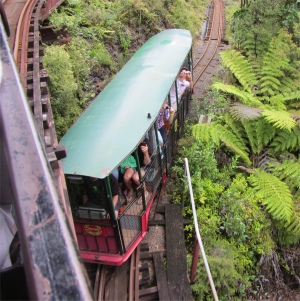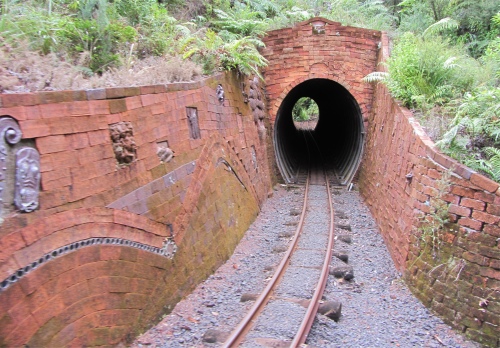We returned back to the working pottery below, now housing studios for resident and visiting potters, and we all melted away in our metallic transporters.
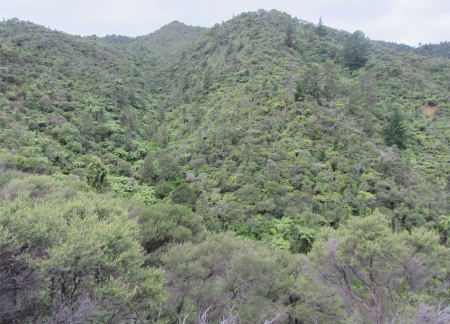
Once Kauri Forest, then Farmland, Now Bush
|
I drove through Coromandel and followed the coast for a while, and spotted a sign pointing to a studio. I quickly took the turning, thinking the studio was by the side of the road, but a drive seemed to climb up a hill. I followed it, then I noticed turn offs, which set me wondering am I supposed to turn off here. Thankfully I spotted a small sign saying "Studio", and I drove into the darkened drive of somebody's property. The property was dark, and I thought no one was around, then a light came on; I was in luck.
A glass door opened, and I was warmly greeted by a chap, Ernie Le Heron, who invited me to step directly into the gallery. A lady appeared around the corner, with a broad smile on her face, announced herself as Barbara von Seida, and shook hands with me. Most of the work on display was Barbara's, but there were a few watercolours present painted by Patrick Greene.
Barbara just bubbled with enthusiasm as she explained her works hanging on the walls, and her approach to her art. She was certainly no method artist, and relentlessly pursued originality. She studied art in Germany, and spent many years using watercolour as her medium. She moved onto acrylics, found them difficult to start with, but now uses them with gusto. The medium in its raw state without the use of retarders suits her style, an immediate, almost aggressive approach, forcing the paint onto boards using large brushes and the occasional finger or palm. Barbara had a passion for converting the subject matter in front of her, usually images from the Coromandel Peninsula, into powerful statements of colour, and it was the use of colour to convey expression and mood that drove her. She took pains to explain this to me, and I could see exactly what she was driving at. I wonder what my Californian artist friend, Marcia, would have made of this style. I imagine the two of them would get on well together.
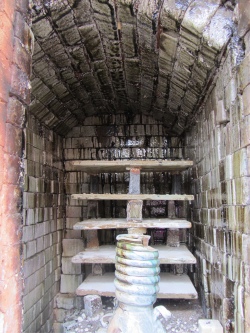
Barry Bricknell Pottery Kiln
|
Barbara was very talented and original, and had won many awards from prestigious societies, and was also much sought after. Indeed she told me a funny story of an artist who had done a Chinese copy of one of her paintings, a compliment indeed, but had not acknowledged Barbara's original. The said artist exhibited the painting, which Barbara subsequently discovered. Barbara then called the lady in question, chatted about the lady's recent change in style, who said that she had received tuition from a fictitious teacher, and then suddenly realised that she was actually talking to Barbara herself, and offered profuse apologies. Barbara could see the funny side, but infringement of copyright can be a messy business. Then there was the time when one of her collectors had two of her paintings stolen; a real claim to fame. How she laughed when she told me that story.
Barbara took time to explain her works to me, but didn't try to ram in down my throat or go for the pushy sale, thank God, that would really turn me off. The pair left me to browse around the gallery on my own. I hovered around the collection, but was drawn to a smaller painting which contrasted with the other predominantly red pictures. This one had cool blues and greens, with a dash of red in one corner echoed by touches of red elsewhere in the painting. To me, this small picture had unity contained in diversity. However, being a humble pensioner, I can't spend money on travel and on paintings. Besides, I wouldn't even contemplate trying to carry a painting to the opposite side of the planet. But I enjoyed the gallery.
I had just finished writing my comments in the guest book when the couple reappeared. We chatted a little more, and I asked if they also publish the work on a website. "We have a website, but we had a problem with our computer some time back, and the chap who fixed it managed to delete the icon that links to the software package that we use, so we have been unable to update it," said Barbara. "As long as you still have the software on your computer, it should be easy to create a link to it," I said. She gave me a quizzical look, as if I was speaking Chinese, but I detected a glimmer of hope in her eyes. "Would you like me to have a look at your computer?" I asked. There was a polite hesitance, the hesitance you get when somebody doesn't want to impose on someone, but I stood up and said, "Let's have a look at your computer."
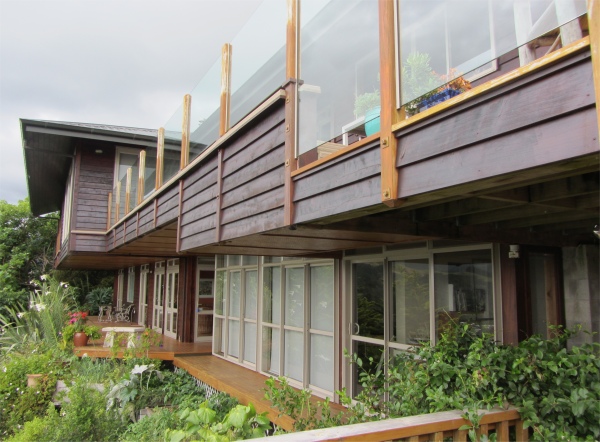
Ernie and Barbara's Cantilevered Front End of Their House
None of What You See Here is Resting on the Ground
|
Ernie and Barbara led me to their work room, and I sat down next to Ernie as he booted up their machine. It was a slow machine showing the typical signs of Windows silting up over time, but once up, I searched for the software package on their machine. Ah, it had been deleted. Barbara knew we could download a free version, which we duly did, and in a short space of time we had it loaded and I put a shortcut icon onto their desktop. We then got into the package and found the route to editing Barbara's website, hey presto. It didn't take long, but they were over the moon. It was a fairly simple task for me, but for them it meant the ability to communicate their website with the world again.
They were so delighted that they asked me to stay for a meal with them, and I was equally delighted to be asked. While Barbara prepared the meal, Ernie poured me an excellent plum juice drink that the couple had prepared as a by-product of their fruit bottling hobby, and then showed me around the unusual property they lived in. It was fairly large, 28m long in fact, with a fair depth to it. However, the ground footprint was not at all large, being confined by the small strip of land that could be built upon safely. This did not deter the couple. To increase the width, they decided to use a cantilevered approach to extend their property at the front, and as he showed me around, I could see a vast amount of the building appeared to be sitting in free space, 45m above the sea below. Ernie explained that to balance this extension, around 250 tons of counterweight sat at the inland side of the house. An engineer had been drafted in to carry out all the calculations to ensure a safe structure was provided, and an architect was employed to design the double pyramid roof structure that they had. I was most impressed with this building. Like Barbara's work, it was highly original, I had never seen a construction like this before.
At the back of the house, a north facing courtyard had been created, with the bush hacked back, and a wall and steps tastefully built up. A lot of effort had gone into this building. And to cap it all, the front gave a most stunning view across the Hauraki Gulf, serving as inspiration for Barbara's work.
As we ate our meal, I learned that Barbara had worked in Cork for 6 years before moving to New Zealand. Sadly Barbara's mother had passed away recently in Cork, which had understandably had an impact upon their lives, and now their artist friend Patrick Greene was ill in hospital too. They were really going through it.
Our conversation turned to travel; the couple loved to travel and they recounted the pleasures to be had in visiting Bali. Indeed they had been there several times and seemed to adore the place.
But sensing the couple had things to do, in fact Ernie's concreting in the courtyard was rapidly going off and need some attention. I thanked the couple for a lovely meal and our time together, wished them well, and let them carry on with their lives. They had been splendid, hospitable and friendly company; typical of Kiwis.
It took me two attempts to find my way back down to the road, and I returned to camp to catch up on my blog. It had been an enjoyable day all round.
